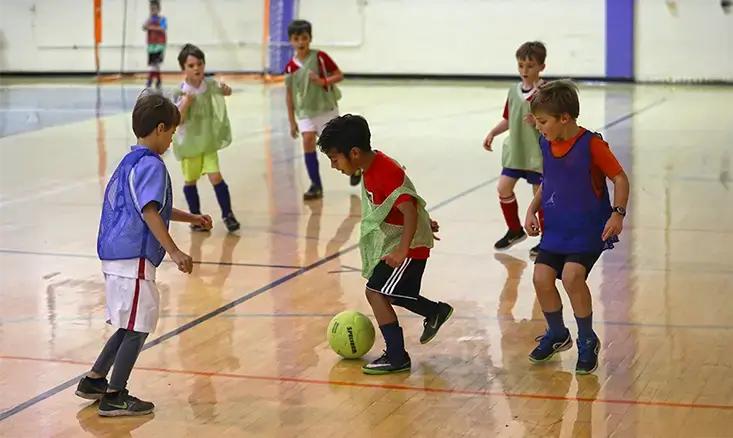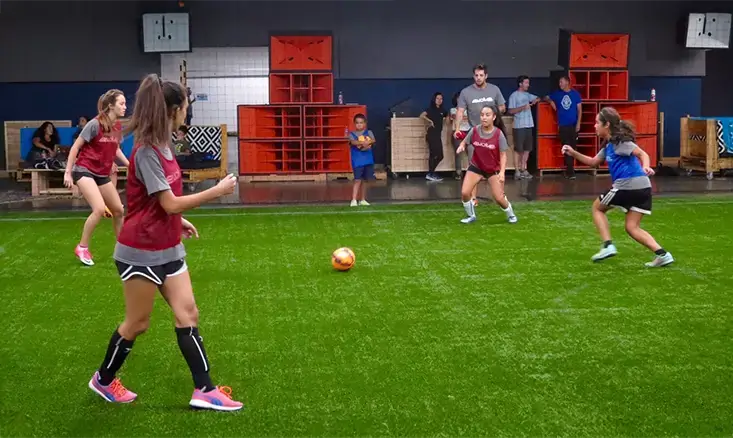CRFC BLOGS
LATEST BLOGS & NEWSLETTERS
Indoor vs Outdoor Soccer: Which One is Best for Young Players?
Soccer is one of the most popular sports worldwide, and for young players, it offers an incredible way to develop athleticism, teamwork, and discipline. But when it comes to training and playing, parents and coaches often wonder: Is indoor soccer or outdoor soccer better for youth players? Understanding the differences between indoor and outdoor soccer is essential for helping young athletes reach their full potential.
The Key Differences Between Indoor and Outdoor Soccer
Both indoor and outdoor soccer offer unique challenges and benefits. Let’s break down the major differences:
1. Playing Field & Environment
- Outdoor soccer is played on large grass or synthetic turf fields, typically ranging from 90 to 120 meters in length.
- Indoor soccer is played in an arena or gymnasium with a walled-off playing field that is significantly smaller.
- Artificial turf is commonly used indoors for better ball control.
2. Game Speed & Playstyle
- The game moves faster indoors due to the smaller field size and walls that keep the ball in play.
- Outdoor soccer requires more endurance and strategic positioning, while indoor soccer emphasizes short-distance sprinting and quick passes.
3. Rules & Regulations
- Offside rule does not exist in indoor soccer, unlike in outdoor matches, where offside positioning can change game dynamics.
- Substitutions: Outdoor leagues typically allow fewer subs, while indoor soccer often allows unlimited substitutions.
- Cleats are prohibited in indoor matches, where players wear indoor soccer shoes instead.
4. Ball Control & Skill Development
- Indoor soccer promotes faster ball control, dribbling, and quick thinking in tight spaces.
- Outdoor soccer encourages long-range passing, aerial play, and goalkeeper training focused on positioning and high saves.

Advantages of Indoor Soccer for Youth Players
1. Faster Decision-Making
Playing indoor soccer forces players to think and react quickly, as they have less space and time.
2. More Touches on the Ball
Due to the walled-off playing field, the ball stays in play longer, resulting in fewer stoppages and increased involvement for all players.
3. Better for Winter Training
Since indoor soccer is played indoors, it allows young players to train year-round, regardless of weather conditions.
Advantages of Outdoor Soccer for Youth Players
1. Greater Physical Endurance
Outdoor soccer involves more running, requiring better fitness and stamina over long periods.
2. More Tactical Awareness
With a larger field, players learn game strategy, spacing, and positioning—key skills for those who aim to play at the professional ranks.
3. Real-Game Conditions
Playing outdoor soccer mimics real professional match conditions, making it a crucial step for serious young athletes.

Goalkeeping: Indoor vs Outdoor
- Height as a goalkeeper is more critical in outdoor games due to high crosses and aerial threats.
- Indoor soccer goalkeeping focuses more on reflex saves and quick dives due to the close-range shots.
- Developing quick decision-making skills is essential in both environments.
Safety Considerations: Which Is Safer?
- Indoor soccer has fewer collisions but walls can cause unexpected injuries.
- Outdoor soccer poses a higher risk of sprains due to uneven playing field surfaces.
- Proper gear and warm-ups can help prevent injuries in both versions.
Which One Should Your Child Play?
It depends on the player’s goals:
- If they want to improve agility, ball control, and play in a fast-paced environment, indoor soccer is great.
- If they dream of playing in outdoor soccer leagues and developing endurance, outdoor soccer is the way to go.

Conclusion
Both indoor and outdoor soccer have their benefits. Whether a young player wants to excel in quick decision-making or build endurance for outdoor soccer, both environments provide unique opportunities. Coaches, parents, and clubs should encourage a balance between both styles to develop a well-rounded athlete.
Frequently Asked Questions (FAQs)
Is indoor soccer harder than outdoor soccer?
Indoor soccer is faster-paced and requires quicker decision-making, while outdoor soccer demands greater endurance and strategic positioning. Each has its challenges, but indoor play often feels more intense due to the smaller field and continuous action.
What are the biggest differences between indoor and outdoor soccer?
The major differences between indoor and outdoor soccer include field size, game speed, rules (no offside in indoor), and play style. Indoor soccer is played on a smaller field with walls, while outdoor soccer is played on a larger grass or turf field with stricter tactical play.
Can you use soccer cleats for indoor soccer?
No, cleats are prohibited in indoor soccer. Players must wear indoor soccer shoes, which have flat soles designed for artificial turf or hardwood surfaces.
Is indoor soccer safer than outdoor soccer?
Indoor soccer has fewer player-to-player collisions, but the walled-off playing field can pose a risk for sudden impacts. Outdoor soccer has more slide tackles and physical challenges, increasing the chance of sprains and injuries.
Which is better for young players: indoor or outdoor soccer?
It depends on the player’s goals. Indoor soccer helps with quick reflexes, ball control, and speed, while outdoor soccer builds endurance, tactical awareness, and long-range passing skills. A mix of both is ideal for overall development.
Why is indoor soccer faster than outdoor soccer?
The game moves faster indoors due to the smaller field size, absence of an offside rule, and continuous play off the walls, making it more high-paced compared to outdoor soccer.
Does playing indoor soccer help with outdoor soccer skills?
Yes! Indoor soccer improves close ball control, quick passing, and fast decision-making, which directly enhance performance in outdoor soccer matches.
Can goalkeepers play both indoor and outdoor soccer?
Absolutely! Goalkeepers benefit from playing both versions. Indoor soccer goalkeeping sharpens reflexes, while outdoor soccer goalkeeping improves aerial control and positioning.
How many players are on an indoor soccer team?
Indoor soccer typically has five to six players per team, whereas outdoor soccer teams field 11 players per side.
Is indoor soccer good for fitness?
Yes! Indoor soccer is intense, requiring speed and acceleration, quick movements, and non-stop action, making it a great cardio workout.
By incorporating both indoor and outdoor soccer into training routines, young players can become more well-rounded athletes!

Did you find this useful?


